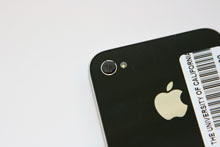 |
| Little lens: A millimeter-wide ball lens is held in front of a cell phone camera’s lens with a piece of rubber. |
The device could mean better and faster diagnoses for patients in poor countries.
Technonlogy Review | Mobile Phones | A cheap lens that enables a cell phone's camera to discern the shapes of cells in a blood sample could make it easier to diagnose conditions such as sickle-cell anemia in places without medical infrastructure.
The system was developed at the University of California, Davis, and is designed to allow field workers to photograph blood samples from patients, and then send the micrographs to doctors via the cellular network for interpretation.
Although others have coupled microscopes to cell phone cameras, the Davis group aimed to make its device inexpensive. It did this by using a very simple lens that is made from a single ball of glass about one millimeter in diameter and held in position in front of the camera with a small piece of rubber. That small size results in a high curvature that provides good magnification, says Sebastian Wachsmann-Hogiu, a physicist with Davis's Center for Biophotonics, Science, and Technology, and the leader of the research team. Because a cell phone camera also uses lenses with a short focal length and a miniaturized sensor with very small pixels, it's optically compatible with the small ball lens. "You couldn't do this with a regular camera, the distances there are too big," says Wachsmann-Hogiu.
The downside of using a ball lens is that the resulting image is significantly distorted, except for in one very small area directly behind the lens. The Davis team solved this problem with software. To take an image using its system, the software takes multiple photos of a blood sample as either the camera or the sample is moved about; the software then combines the images into a larger, undistorted image. The current prototype can resolve features about 1.5 micrometers across.
While the system was developed using a relatively expensive iPhone 4 with a five-megapixel camera, Wachsmann-Hogiu says it could be adapted to cheaper phones with one or two megapixel cameras, which are more likely to be found in poor countries. Wachsmann-Hogiu believes that with mass production, an accessory based on a plastic, rather than glass, lens design could be produced for around $2, cheap enough to be broadly adopted in poor countries. 










0 comments:
Post a Comment